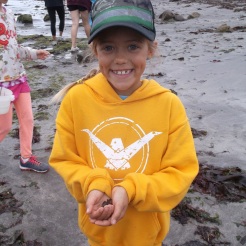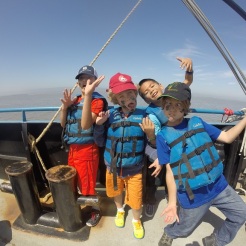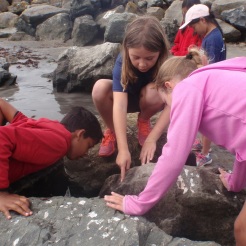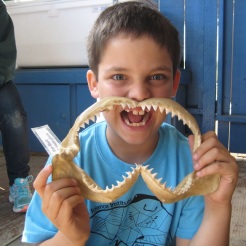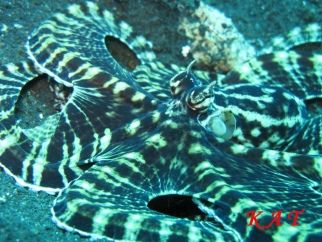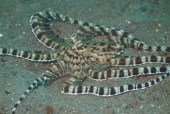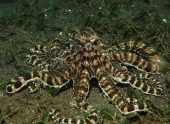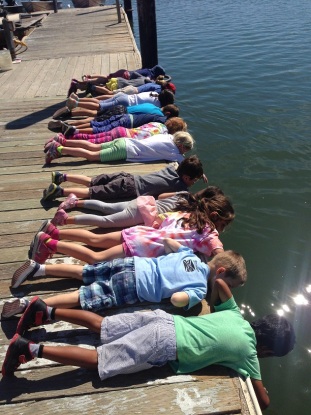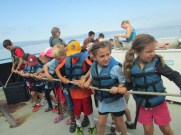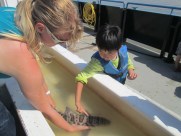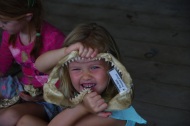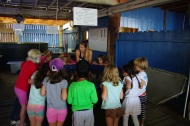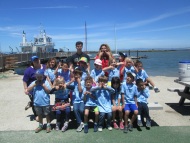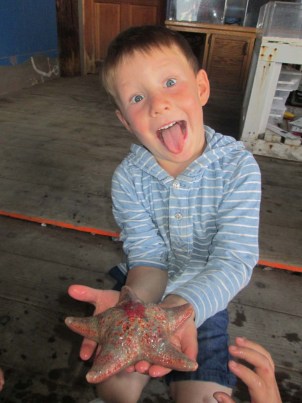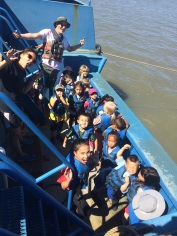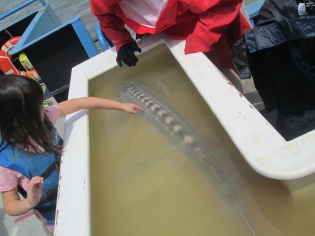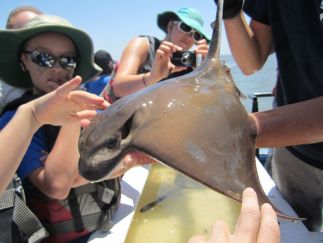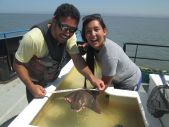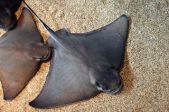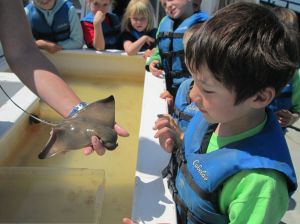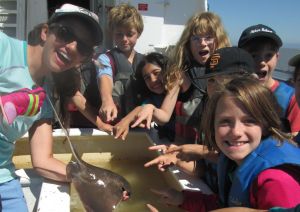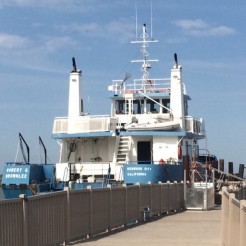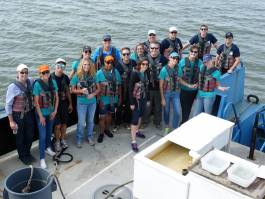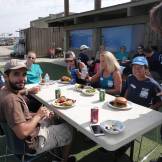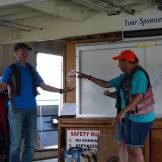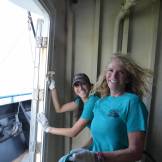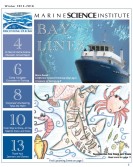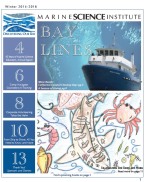#marine science
Entering 2nd-5th graders have two camp options: Wetland Explorers (discussed in a blog from 2 weeks ago found HERE) or Ocean Explorers, a camp of similar structure but focusing on a different habitat. Ocean Explorers camp is about “whole world’s ocean” and how we are connected to it. Campers will learn about various habitats such as the highly productive kelp forest, the harsh sandy beach, the ever-changing rocky shore and the dramatic open ocean which is strongly characterized by physical factors. Diverse populations of marine algae and animals are found along the rocky coast as well as in the open ocean. Wind, sunlight, tides and other physical factors create a complex environment, and the animals that are a part of northern California’s coastal community have incredible adaptations for survival.
Ocean Explorer camp, as well as MSI’s other camp options, is geared toward California’s science standards taught during the school year, and is fun and interactive. Hands-on lessons, animal touching, games, crafts, songs and more are themed toward the material to engage campers to embrace the communities along our nearby coastline.
All Ocean Explorer camps have:
- 2 days at our site to study live animals from our aquarium and to engage in other science projects both indoors and outside
- 2 field trips (reached by school bus) that feature different habitats
- 1 day aboard our ship that includes fishing, studying plankton, sampling mud, and learning about nautical navigation
- 2 staff plus a volunteer for every 15 campers
- Flexible curriculum that engages multiple learning styles
Campers will be going on two field trips during their week at camp: Bean Hollow State Beach and the Gulf of the Farallones National Marine Sanctuary Visitor Center. Bean Hollow (along the coast about 17 miles south of Half Moon Bay) offers ample opportunity for tide pool exploration and other activities. Campers will be able to find hermit crabs, black turban snails, sea anemones, purple shore crabs, sea stars with 5-6 arms, and more! This region also offers a coastal walk where campers can spot common native and non-native coastal plants, and even find a harbor seal haul-out where these marine mammals are commonly seen resting on the rocks.
The second field trip is a visit to the Gulf of the Farallones National Marine Sanctuary Visitor Center in San Francisco. Located near Crissy Field, this facility has been transformed from old Coast Guard Buildings and is found along the beach. Campers will explore the region looking for crabs along the shoreline and taking part in crab population surveys. They will also drag a plankton net through the water and compare the coastal plankton to that found in the south Bay at our facility. Campers will also take part in a marine debris project with the Ocean Conservancy; they will contribute to a survey in which they will account for and tally the number of trash items found. The data will be entered into a database and submitted to the Ocean Conservancy, which will be compiled and become a part of a report for the city of San Francisco and contribute to the global project placed by the Ocean Conservancy.
Join us for a week full of fun, lessons, games, and interactive activities that are sure to excite your camper and inspire their love for the life within the California coastline and open ocean. Camps run Monday through Friday, 8:30am-3pm with extended care available until 5:30pm. Camp July 5th-8th still has spots available!
OCEAN EXPLORER SCHEDULE:
June 13-17 – FULL
June 20-24 – FULL
June 27-July 1 – FULL
July 5-8
July 11-15 – FULL
July 18-22 – FULL
July 25-29 – FULL
August 1-5 – FULL
August 8-12 – FULL
Marine Camp 2016: Ocean Explorers Sneak Peak. Learn about California’s coastal marine life! Entering 2nd-5th graders have two camp options: Wetland Explorers (discussed in a blog from 2 weeks ago found…Common Facts:
Scientific name: Gramma loreto
Diet: Small crustaceans, parasitic organisms found on larger fish, plankton
Size: Up to 3 inches
Range: Western Atlantic Ocean—Florida to northern South America and the Caribbean Sea
Despite their tiny size, Fairy basslets are hard to miss. With their bright purple and yellow bodies, it’s easy to spot these darting flashes of color. Fairy basslets are coral reef inhabitants and can generally be found under ledges or in caves.
“Fairy basslets are known to swim upside-down under ledges and along cave ceilings. They live in colonies and defend their territory from other species and even from other fairy basslets. Male fairy basslets guard and care for the eggs and the nest.”
Males find and establish nest sites before they participate in spawning activity. They find small crevices and holes in the reef and line them with algae, to cover the opening. Then, at dawn, female basslets will come to the nesting sites and deposit their eggs in a nest. After 10-11 days, the male’s guard duty is complete and the eggs hatch. “Then the larvae are believed to proceed to the planktonic stage until they are sufficiently heavy to resettle on the reef.”
Something interesting about Fairy basslets is that they are all born female, but can change sex to male. Males are more colorful than females and darken when they are ready to mate. Males also become a little bit larger than the females.
Fairy basslets are a beautiful and fun fish to observe! Take the time to admire them if you ever happen upon them.
Sources:http://www.fishlore.com/Profiles_Fairy_Basslet.htm
http://www.eoearth.org/view/article/152728/
http://www.aqua.org/explore/animals/fairy-basslet
Written by: Kari Shirley, intern
I’m 3 inches long, purple and yellow, and live in coral reefs. Who am I? Common Facts: Scientific name: Gramma loreto Diet: Small crustaceans, parasitic organisms found on larger fish, plankton…It’s not often that you find a fish that would rather walk than swim. Meet the walking fish!
Common Facts: Scientific name -Brachionichthys hirsutus Size - 10-15 cm Diet - Small crustacea and worms…
Opportunities are abound in the Wetland Explorer camp for 2nd-5th graders. This camp explorers our local habitats and the animals that inhabit our incredible backyard. Campers will explore the life found in our local estuary, marshes, sloughs and mudflats. With Bair Island Ecological Reserve across the waterway from Marine Science Institute, campers will be inspired and curious about the vast array of wildlife this area offers. This shoreline habitat makes the Bay ecosystem healthier by providing homes for diverse animals that live only in this habitat, migratory birds that use the marsh as a pit-stop along their route, and by acting as a sponge by filtering pollutants and heavy metals from run-off.
During their week learning about the San Francisco Bay’s wetlands, Wetland Explorers will discover the animal life that calls our estuarine habitat home. This camp is geared toward California’s science standards taught during the school year, and is fun and interactive. Campers will touch animals and participate in hands-on activities, games, crafts and songs tailored toward the material.
All Wetland Explorer camps have:
- 2 days at our site to study live animals from our aquarium and to engage in other science projects both indoors and outside
- 2 field trips (reached by school bus) that feature different habitats
- 1 day aboard our ship that includes fishing, studying plankton, sampling mud, and learning about nautical navigation
- 2 staff plus a volunteer for every 15 campers
- Flexible curriculum that engages multiple learning styles
The first field trip is to the San Francisco Maritime National Historical Park in San Francisco. Here campers will tour the only square-rigged ship left in the San Francisco Bay area, the Balclutha. Built in 1886, the Balclutha was a cargo ship that traveled around the world and now resides in San Francisco as a National Historic Landmark. Campers will learn sea shanties and learn how the San Francisco Bay became one of the world’s largest and most important seaports. Campers will also explore birdlife and invertebrates through activities with binoculars and on the docks at the aquatic park. Kelp crabs, giant bay anemones and nudibranchs as large as your hand will fascinate Wetland Explorers as they compare the invertebrate life in this North Bay area with that found on our docks in the South Bay.
The second field trip is to the Pescadero Marsh Natural Preserve, which includes the only extensive wetland along the coast of the San Francisco peninsula. This area hosts extensive flat hiking trails where campers will utilize binoculars and bird field guides to spot some of the 60 species of birds that nest in the marsh (and 200 that fly through it!) and the importance of the marsh as a breakpoint along the Pacific Flyway. They will also use field guides to identify and differentiate between native and non-native plant species. We can even spot harbor seals as they surface, or leopard shark fins as they search along the bottom for food during low tide!
The Wetland Explorer camp is an excellent option for young scientists to learn about our nearby marine habitats. All Instructors have a degree in Marine Biology, Environmental Science, Education or a related field, and many have field research experience and will emphasize different aspects of the curriculum. Each instructor has their own unique teaching style so no two weeks of camp are the same.
Join us for this unique experience as campers explore the science that is practically in their backyard. Camps run Monday through Friday, 8:30am-3pm with extended care available until 5:30pm.
WETLAND EXPLORER SCHEDULE:
June 13-17
June 20-24
June 27-July 1
July 11-15
July 18-22
July 25-29
Marine Camp 2016: Wetland Explorers Sneak Peak. See what’s in store for our campers! Opportunities are abound in the Wetland Explorer camp for 2nd-5th graders. This camp explorers our local habitats and the animals that inhabit our incredible backyard.Common Facts:
Scientific name –Phycodurus eques
Size – Up to 16 inches long
Diet – Krill, mysids, sea lice
Range – South and Western Australia
If you were scuba diving along the rocky reefs of Southern and Western Australia, you might never spot one of the beautiful Leafy sea dragon! For a couple of different reasons. First, these fish are rare. And second, they are camouflaged to blend in perfectly with the seaweeds and seagrass around them!
Leafy sea dragons are related to sea horses, and have a similar body type—except they don’t use their tail to grip things like sea horses do. And they have some extra frills that seahorses do not. “Sea dragons are some of the most ornately camouflaged creatures on the planet. Adorned with gossamer, leaf-shaped appendages over their entire bodies, they are perfectly outfitted to blend in with the seaweed and kelp formations they live amongst.”
Leafy sea dragons have small dorsal and pectoral fins that they use to awkwardly swim through the water. Although a lot of the time, they enjoy just letting the current carry them, like the seaweed they are mimicking.
Something interesting about Leafy sea dragons is that the males are the ones that do the child-bearing! The females deposit their eggs on a brood patch the males have on the underside of their tails. The eggs are fertilized in this process, and then the males carry them for 4-6 weeks until they hatch. Luckily for the parents, the work is then done. Baby sea dragons are independent from birth.
Due to their excellent camouflaging skills, Leafy sea dragons have very few predators, outside of humans. Humans love to catch them and keep them as pets because they are such beautiful creatures. Australia currently has a ban on hunting/fishing/disturbing Leafy sea dragons in the hopes that their numbers will increase.
Sources:
http://www.montereybayaquarium.org/animal-guide/fishes/leafy-sea-dragon
http://animals.nationalgeographic.com/animals/fish/sea-dragon/
Written by: Kari Shirley, intern
Meet the Leafy Sea Dragon–the expert at camouflage! Common Facts: Scientific name -Phycodurus eques Size - Up to 16 inches long Diet - Krill, mysids, sea lice…Common Facts:
Scientific name – Thaumoctopus mimicus
Diet – Small fish and crustaceans
Size – Up to 2 feet long, with 25 centimeter arms
Life span – Said to live for around 9 months
Initially, if you happened upon a Mimic octopus, you would think that it was just a normal, slightly small, octopus. But the Mimic octopus is not your typical octopus. These sea creatures have LOTS of tricks up their sleeve.
It is the behavior of the Mimic octopus that makes it stand out and gives it it’s name. “Mimicry is commonly used as a survival strategy in nature. However the mimic appears to be able to take on the appearance of not just 1 other species, but of several.” Not only that, but all of the other species that the Mimic imitates are venomous, making this a deliberate and evolved tactic of survival.
The Mimic octopus can make itself appear to be a Lion fish, sea snake and a sole/flatfish. It bends and shapes it’s body to look just like theirs. Below is a video showing the Mimic octopus in action.
The Mimic octopus also has a lot of the same physical characteristics of other octopus species have. They have the ability to change the color and texture of their skin to blend into their surroundings to protect themselves. They have “8 arms, a mantle containing 3 hearts and other internal organs, and a siphon used for jet propulsion. The arms have 2 rows of suckers, each sucker having a touch sensor and a chemoreceptor, allowing the mimic effectively to feel and taste its food before it eats it. It has a large brain but lacks the sense of hearing.”
Sources:http://www.dive-the-world.com/creatures-mimic-octopus.php
http://marinebio.org/species.asp?id=260
Written by: Kari Shirley, intern
The Mimic octopus is not your typical octopus. They have LOTS of tricks up their sleeve. Common Facts: Scientific name - Thaumoctopus mimicus Diet - Small fish and crustaceans Size - Up to 2 feet long, with 25 centimeter arms…Campers entering Kindergarten through 1st grade have an exhilarating week ahead of them as Plankton Pioneers!
This camp introduces your budding biologist to the wonders of our amazing local marine life, both in the San Francisco Bay and in our world’s ocean. They will experience the animals and habitats first hand through a variety of fun-filled interactive activities. Campers will learn about and touch live animals in a safe and exciting environment, and participate in themed crafts, games, songs and stories. These activities spark excitement about nature and will inspire campers to appreciate our local life!
Each day of camp has a different theme, enabling campers to explore different aspects of marine science. Plankton Pioneers will also create fun crafts, including decorating their own reusable tote bag with marine animal designs and creating their own jelly to play with. They will also spend a day on board our 90’ research vessel, surveying animals from the San Francisco Bay! This ship was designed specifically for teaching programs in the San Francisco Bay. Join us as we go fishing, survey mud and invertebrates, study plankton, sharks, and so much more!
Camps run Monday through Friday select weeks from 8:30am-1pm. Extended care is available until 5:30pm.
Camp availability:
June 13-17 – FULL
June 27-July 1 – AVAILABLE
July 5-8 – AVAILABLE
August 1-5 – FULL
August 8-12 – FULL
Space is available – join the Plankton Pioneers today!
Marine Camp 2016: Plankton Pioneers Sneak Peak Campers entering Kindergarten through 1st grade have an exhilarating week ahead of them as Plankton Pioneers!Scientific Name: Delphinapterus leucas
Size – 13 to 20 feet, 2000 to 3000 pounds
Life span – 35 to 50 years
Diet – Fish, crustaceans, and worms
Beluga whales are born to stand out—with their unusual white color, they are easy to spot and recognize. They aren’t always this color though. Baby Belugas are born gray or brown, and then fade to white as they mature sexually.
Compared to most whales, Belugas are small, ranging from 13-20 feet in length. They are also unique because they lack a dorsal fin, something most fish and marine mammals have. There are several other things that make Belugas special. They have a more complex way of communicating with one another, utilizing clicks, whistles and clangs, along with other sounds that they sometimes mimic.
Beluga whales can be found in the coastal waters of the Arctic Ocean, and in subarctic waters as well. Belugas almost always live and travel in small groups call Pods. They migrate south when the ocean begins to freeze over and have to move quickly, otherwise they could be trapped under the ice and suffocate—or become an easy target for predators, like Polar Bears.
You might wonder why Beluga whales live in such a frigid environment. They have a thick layer of blubber (which can be as thick as 5 inches!) to help keep them insulated and warm. They also have a hard dorsal ridge along their back and a tough forehead, which helps them to swim through the icy sea water.
Beluga whales are truly amazing and beautiful creatures. Should you ever be near arctic waters, take some time and see if you can spot these fantastic white whales! They are worth the wait.
Sources:http://us.whales.org/species-guide/beluga-whale
http://www.defenders.org/beluga-whale/basic-facts
http://animals.nationalgeographic.com/animals/mammals/beluga-whale/
Written by: Kari Shirley, intern
Beluga whales are born to stand out—with their unusual white color, they’re easy to recognize! Scientific Name: Delphinapterus leucas Size - 13 to 20 feet, 2000 to 3000 pounds Life span - 35 to 50 years…Common Facts:
Scientific name – Stenella longirostris
Diet – Small fish and squid
Size – 6-7 feet, 130-170 pounds
Lifespan – up to 20 years
Most of us are familiar with dolphins—the fun and playful porpoises that can often be seen leaping out of the water to socialize with each other and with humans. One type of dolphin that you may not be as familiar with is the Spinner Dolphin.
Spinner dolphins are named after their above the water theatrics—they love to leap out of the water and spin a few times on their body axis while doing so. Some can spin as many as four times around in one leap.
These dolphins love to stay together and are usually found in huge groups. They do their hunting at night, feeding mainly on mid-water fishes and deep-water squid, and then they rest during the day time.
Spinner dolphins can been found all over the world, mainly in tropical and subtropical oceans. For some reason, Spinners tend to follow groups of Yellowfin Tuna around. Because of this, fishermen seeking Tuna will often track the dolphins in order to get to them. Oftentimes, the dolphins are caught in the nets with the tuna, and because of this, their population is decreasing.
Thankfully, “Fishing methods for tuna imported into the U.S. under the Dophin-Safe program do not allow fishing practices, such as setting on dolphins.” The Spinner Dolphin population is at a stable number right now.
So if you are ever in a warm and tropical area, close to the ocean, stay alert to see if you can see any Spinner Dolphins. If you do, you are in for a show!
Sources:http://acsonline.org/fact-sheets/spinner-dolphin/
http://www.nmfs.noaa.gov/pr/species/mammals/cetaceans/spinnerdolphin.htm
Written by: Kari Shirley, intern
Meet the species of dolphin that REALLY knows how to have fun! Common Facts: Scientific name - Stenella longirostris Diet - Small fish and squid Size - 6-7 feet, 130-170 pounds…Wanted: Engaging, high-energy, compassionate and fun instructors and counselors to lead our summer camp! CLICK HERE to apply and join the team.
Marine Science Camp is proud to have a passionate and fun team of instructors, counselors and volunteers each summer. The foundation of this team of educators and leaders is not only their knowledge of marine science, but also their ability to inspire campers. They spark an appreciation for marine science and local habitats while promoting friendship, teamwork, and curiosity.
Our qualified team of highly motivated instructors, counselors and volunteers are outside with the campers every day. Instructors and counselors facilitate hands-on learning and teambuilding in a safe and fun environment. They are CPR and First Aid certified, background checked, and undergo an extensive 2 week training period prior to camp.
Instructors have a minimum of a bachelor’s degree in fields varying from biology and marine science to education and environmental studies or other similar fields. Most teach with MSI throughout the year; they are dedicated, experienced and have taught a variety of programs to grades from pre-kindergarten through college. Instructors at Marine Camp lead camper learning, supervise campers and are primarily in charge of safety. They are the crew of our 90 foot research vessel and undergo extensive training and regular safety drills to comply with Coast Guard safety standards. Many have field research experience and relate it to topics learned at camp. Our fantastic Instructors are role models who inspire and share their passion for marine science with campers of all ages.
Marine Camp Counselors are in college or have already received their degrees. They work closely with the Instructors helping with activities, assist in overall supervision and aid in providing an understanding of marine topics. Many of our counselors are pursuing degrees in the sciences and are interested in marine science or education as a career. Marine Camp is an excellent summer opportunity for them to get first-hand experience.
Rounding out the summer staff are our amazing volunteers, who are a crucial part of the summertime fun. They act as an extra set of eyes, ears and hands, and they also act as role models to ensure our campers are staying safe and having fun. Volunteers join staff and campers for every activity and field trip. They are buddies, helpers, and friends to each and every camper—especially the campers that benefit from having just a little extra help making friends and getting involved. Volunteers join us for different amounts of time—for just one week to almost the whole summer! Some of our campers have become volunteers, who later become Counselors and Instructors! We are so grateful to have these inspiring and energetic people as a part of our team. CLICK HERE to learn more about volunteer opportunities during the summer and beyond.
If YOU match any of these descriptions, CLICK HERE to learn more and apply. I look forward to greeting new and old members onto the team.
Marine Camp 2016: Wanted – Enthusiastic and Fun Camp Staff Wanted: Engaging, high-energy, compassionate and fun instructors and counselors to lead our summer camp! CLICK HERE…Common Facts:
Diet – Jellyfish, small fish, zooplankton and algae
Size – Up to 14 feet
Weight – Up to 5,000 pounds
Habitat – Open Waters
Sunfish, also known as Mola, are one of the largest fishes to be found in the ocean. Out of all the bony fish, they are heaviest. The largest Sunfish have been known to reach 14 feet vertically and 10 feet horizontally and can weigh up to 5,000 pounds. Which is a little shocking for a fish that looks so much like a pancake.
“Sunfish, or mola, develop their truncated, bullet-like shape because the back fin which they are born with simply never grows. Instead, it folds into itself as the enormous creature matures, creating a rounded rudder called a clavus.” Their odd shape makes them awkward swimmers. They use their dorsal and anal fins to move and steer with their clavus.
Sunfish can be found in the warm and tropical oceans around the world. They love to rest just below the surface of the water, so that they can bask in the sun, hench the name Sunfish. Sometimes, when one of their big fins sticks up out of the water, people mistake them for sharks. But don’t be alarmed, Sunfish are not a threat to humans.
Oftentimes, Sunfish become infested with skin parasites. When this happens, they allow small fish and sometimes even birds to peck at their skin and get the parasites out.
Sunfish love to eat jellyfish, it is their main source of nutrients. Unfortunately, at times, they mistake plastic bags floating in the ocean as jellyfish, and have been known to choke on the bags. So be aware of your surroundings when you are at the beach! If you see trash, pick it up! You may be saving one of these beautiful, gentle creatures.
Written by: Kari Shirley, intern
Sources:http://www.montereybayaquarium.org/animal-guide/fishes/ocean-sunfish
http://animals.nationalgeographic.com/animals/fish/mola/
I’m one of the biggest, heaviest and most gentle fish to be found in the ocean! Read about me! Common Facts: Diet - Jellyfish, small fish, zooplankton and algae Size - Up to 14 feet…Common Facts:
Scientific name – Myliobatis californica
Habitat – Sandy seafloors
Range – Eastern Pacific from Oregon, to the Sea of Cortex and near the Galapagos Islands
Diet – Molluscs, crustaceans, small fish
Size – Female can reach wingspans of 6 feet and weights of 200 pounds, while males are smaller
Life Span – Up to 35 years
The Bat Ray is an animal that we see often at the Marine Science Institute because many of them live here in the San Francsico bay! These graceful creatures get their name from not only the way they look, but they way they swim. They swim by flapping their pectoral fins (which have a strong resemblance to wings). They love to hang out in muddy and sandy bottomed bays, kelp forests and near coral reefs.
Bat Rays use their “wings” for more than just moving around. They flap their fins to stir up the sand on the ocean floor to expose potential food sources. Once they find something to eat, like a clam, they can use their snout to dig them up. Bat Rays have teeth that are fused into plates. This enables them to crush almost any clam shell. They crush the shell, spit out the shards and get the soft and fleshy parts. And lucky for Bat Rays, their teeth are constantly growing! So if a tooth ever breaks, they have nothing to worry about—it will be replaced soon.
Bat Rays tend to be lone riders, except when it’s mating season or time to feed. Female bat rays carry their babies for 9-12 months before giving birth. And they can give birth to 2-12 pups! Depending on how big the mother is.
If you’re ever swimming and see a Bat Ray, it would be better to keep your distance. These creatures have 3 poisonous barbs on their tails that they use to defend themselves from predators. And they won’t stop to ask if you are friend or foe before they use them!
Sources:http://www.montereybayaquarium.org/animal-guide/fishes/bat-ray
http://www.aquariumofpacific.org/onlinelearningcenter/species/bat_ray
Written by: Kari Shirley, intern
It’s smooth! It’s graceful! It’s fierce! It’s the Bat Ray! Common Facts: Scientific name - Myliobatis californica Habitat - Sandy seafloors Range - Eastern Pacific from Oregon, to the Sea of Cortex and near the Galapagos Islands…Summit Public Schools is a high performing charter school organization with seven schools in the Bay Area, including two high schools in Redwood City, Everest and Summit Prep, and two in San Jose, Tahoma and Rainier. Internships are a part of their unique Expeditions program and take place during the school year and school day. They provide an invaluable opportunity for students to get some adult work world experience, explore a possible career, develop confidence and strengthen their communication skills.
During internships students are required to submit journal entries weekly to their advisors. This week I would like to share Danielle’s journal entry.
Journal Question #2: Talk about something new that you have learned at your internship. Describe what you learned, how you learned it, and what it helped you understand or do at your internship. Will you be able to use this new knowledge or skill in the future?
Danielle: While interning at the Marine Science Institute, I have learned a lot about what being a marine scientist might be like, and what goes on behind the scenes of the programs. When I did a trip out on the boat as a data collector, I learned how marine scientists figure out how many of a species are in a given area. When the kids in the class brought in a trawl, I counted and measured the fish, then recorded it in a data base. I also learned more about the life in the bay as I shadowed the classes that happen on shore. I shared the kids enthusiasm toward the marine life and was happy to help the kids learn to identify the different types of fish and invertebrates that they brought up. I am learning to identify the fish too, so I love to practice. I also learn about setup and cleanup, which is how to take out and put away the fish, and clean the buckets we put them in.
I also learned what the office work looks like. The first intern session I had I spent a lot of my time in the office cutting pamphlets and newsletters, and getting gifts ready to send to volunteers. That taught me more about how a nonprofit is run, and how much they are thankful for their volunteers. I also go the chance to see how the data that is collected in the bay is sorted and cleaned of unusable data.
I find that knowing these skills can be very useful. Right now I am working on a project for my school program that is allowing me to be at MSI as an intern. For the project, I am analyzing data from four years leading up to the El Nino, and comparing it to the last one. I realized that this can be important because the El Nino affects more than the weather.Learning the trends helps us understand more about these phenomenons.
Volunteer and internship opportunities are available year round.
Please visit our webpage at www.sfbaymsi.org to find your next volunteer position!
Marine Science Institute is a tax-exempt 501©(3)not for profitorganization
©2016. All Rights Reserved
California sea lions love to swim fast and bark underwater. Read more about them below!
Common Facts: Scientific name - Zalophus californianus Average life span - 30 years or less Diet - Fish, shellfish, squid…
“I’d rather be fishing” is a common thought that goes through many a “nine-to-fiver’s” mind during the workweek. Well, we lucky folks at Emergence Capital got to do just that and more. 5
On a gloriously sunny October day, we picnicked outside with the staff on their oyster shell beach. Over hamburgers and chocolate chip cookies we learned of their strong interest in marine biology and the changes they have seen in the environment over the years. MSI’s Executive Director, Marilou Seiff, then expertly took us on a guided tour of the facilities, which showcased varied opportunities for school children to visit and learn onsite. From there, we boarded the R/V Robert G. Brownlee and set off to work! MSI’s Community Outreach Coordinator, Tiff Murzi-Moyce, guided us through a physically competitive challenge of teams pulling up the fishing nets. We later experienced how to safely handle the fish. We in turn gave back by cleaning the boats interior with a lot of elbow grease and laughter.
A huge “thank you” to everyone at MSI for sharing with us the valuable work they do every day. The employees at Emergence Capital definitely felt that our community goals were met and our anticipation of the day’s activities hit the mark.
-Adrian Mallinger, Executive Assistant at Emergence Capital in San Mateo.
Marine Science Institute would like to thank Adrian for submitting this article, coordinating this event, and spearheading her company’s donation process to replace the carpet on our research vessel. We also want to send a big THANK YOU to the Emergence Capital team for their hard work and dedication in making this cleanup day a huge success.
Volunteer and internship opportunities are available year round.
Please visit our webpage at www.sfbaymsi.org to find your next volunteer position!
This article was featured in our BayLines Winter Edition 2015-2016.
Marine Science Institute is a tax-exempt 501©(3)not for profitorganization
©2015. All Rights Reserved
Once again, San Mateo County residents came out by the thousands to clean up trash around the county on Coastal Cleanup Day, which took place Saturday, September 19. Residents on both the coast and bayside of the county slogged through sand, waded through mud, and climbed hillsides with buckets and bags, trash pickers and gloves, and a whole lot of spirit. Young and old participated as groups of friends and families turned out to make a difference in three short hours on the hot and sunny day.
Together, volunteers gathered an estimated 27,000 pounds of trash and over 3,700 pounds of recyclables from roadways, beaches, fields, and mud flats. Approximately 61 miles of total shoreline was cleaned by an estimated 4,165 volunteers at over 53 sites. Volunteers even found a lizard trapped in a crushed beer can!!! Check out some of the images taken from around San Mateo County on Coastal Cleanup Day below. Each year, this event shows how much of an impact we can make in our community by working together with so many different people throughout the County. Because of volunteers working together, nearly 320,000 pounds of trash has been picked up since 2005! To those volunteers reading this, thank you thank you thank you!!!
If you were not able to make it out this year, you can still make a difference. Coastal Cleanup Day is always the 3rd Saturday in September each year, so it is easy to mark your calendar now and plan for years to come. In addition, regular cleanups take place throughout the year all around the county.
Remember, if everyone does a little bit, together we can accomplish a lot!!
Excerpt provided by San Mateo Countywide Water Pollution Prevention Program,click here to see their blog.
Go to www.flowstobay.org/litter to find out about other cleanups, or sign up to receive their monthly calendar of events
that includes cleanups and other watershed activities like hikes, habitat restoration, and wildlife observation.
Corporate and individual volunteer opportunities are always available. To learn more please visit our webpage at www.sfbaymsi.org or contact the Community Outreach Coordinator at 650-364-2760 X16 or by email [email protected]
This article was featured in our BayLines Winter Edition 2015-2016.
Marine Science Institute is a tax-exempt 501©(3)not for profitorganization
©2015. All Rights Reserved

This photo has stuck with me for years. Balance in all things. @annieguttridge on Instagram

It’s a bird, it’s a plane, it’s…a sea slug! The spanish dancer nudibranch brings a new level of excitement to diving with slugs. Where most nudis amble slowly over their environment, the spanish dancer can actively swim by twisting its body and pumping water with its large, flowing “skirt.” The fluffy tuft on its back end are actually gills, and give the nudibranch its name - nudi meaning naked, and branch meaning gills! Found at @reefdivers on Instagram.

You’ve heard of a hammerhead shark, but have you ever heard of a winghead shark? Little is known about this eccentric-looking species and why they’ve evolved such an exaggerated hammer-head, called a cephalofoil, though the current popular theory is that the larger surface area is simply better at detecting prey buried beneath the sand. The youngster in this image was captured for tagging and released. This species is endemic to northern Australia and is classified as Near Threatened.
Photo credit: Dr. Tristan Guttridge

Reach for the sky! Thresher sharks have been reported for their flying leaps out of the water, but that behavior is rarely captured. It’s also a treat to see the shark’s iridescence so clearly beneath the sunlight. I hope that remora enjoyed its unscheduled flight! Found via @ah360views on Instagram.

